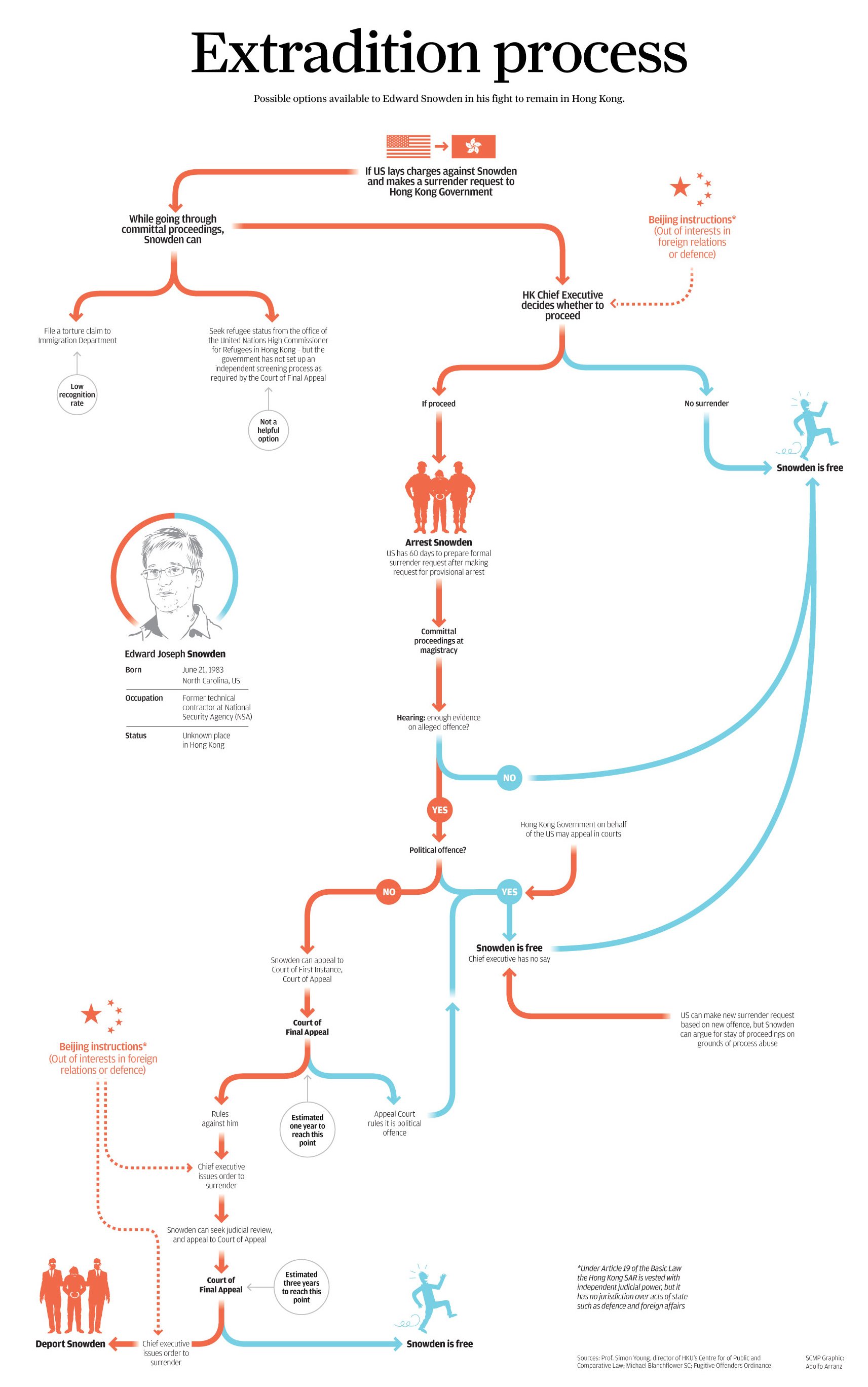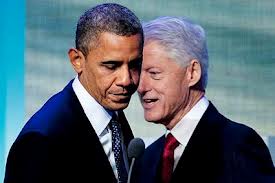Six reasons why choosing Hong Kong is a brilliant move by Edward Snowden
By MsExpat, a journalist and essayist who lives in New York and Hong Kong and Fellow of The Mighty Corrente Building. Originally published at Corrente.

This infographic from the South China Morning Post gives you a good picture of all the potential routes that Snowden’s case might take through our legal system. The main thing to note here is the “typical” length of time it takes to move a case between the various appeal courts: a year from the Court of First Instance to the Court of Appeal, and another 3 years to the Court of Final Appeal. As there is nothing “typical” about this case, and since Hong Kong barristers and judges, following the British legal system, worry and deliberate every fine point to death, Snowden’s case could easily drag on longer. The most infamous American citizen to grace a Hong Kong courtroom in this century, “Milkshake Murdress”Nancy Kissel, has been dragging out for 10 years, a trial, an appeal, a re-trial and now another appeal.Word has it that Beijing may “solve” the problem of what to do about Snowden in the easiest way possible–by encouraging the Hong Kong courts to take their time. Not that Hong Kong courts ever need any encouragement to take their own good time–even a decade– making absolutely, positively sure that justice is served.
2. Snowden can settle in and feel right at home, since Hong Kong is the Geek-friendliest city in the world. Even if I wasn’t on the run, if I were a cyber-whiz kid, I’d salivate at the prospects of being based in Hong Kong. Since we lack space and spend lots of time cooped up in small rooms, we have taken to the virtual world like ducks to water. There are something like 2.3 SIM cards in use for every resident of Hong Kong (that’s a higher ratio than our birth rate). Budding spies and others of a paranoid nature can buy a couple of those SIM cards to swap in and out of their (unlocked) phones for $10 in any 7-11, no registration, no questions asked (try doing that in India or Argentina!)
In addition to phones, we are wired up the wazoo, and fibre optic Broadband is pretty much standard everywhere. My connections in HK are waaay better, and far cheaper, than any Internet service I’ve ever had in New York City. And we’ve got so much bandwidth that much of our cable TV is delivered through broadband Internet connections. During the Taiwan earthquake a few years ago, the main trunk Internet cable between Asia and North America got damaged and went down for 6 weeks–but no problem. Hong Kong is connected in the other direction too, via a fat cable to Europe. When it comes to international communications, we’re probably one of the best locations in the world.
Unlike mainland China, our Hong Kong Internet is unaffected by the censorship of the Great Firewall of China. We’ve got Facebook, Twitter, and lots of Chinese language social media boards too. And because our citizens spend so much time in the online universe, we are especially savvy about the issues surrounding Internet freedom, and are quite vigilant against both governmental and corporate abuses of it. Which leads to another reason why Snowden’s instincts might have led him to HK:
3. Local Popular Support. The other day, Hong Kong legislative councillor Leung Kwok Hung launched a small protest in support of Snowden at the US Consulate, a curtain-raiser for the larger demonstration that’s being planned for this Saturday. During the mini press conference at the gates of the consulate, a Chinese reporter asked Leung what was the relevance of Snowden’s plight to Hong Kongers. Without missing a beat, he answered, “Do you use a mobile phone? Do you surf the web?”. Unlike the reporter, most young people in Hong Kong aren’t so clueless and they’ve made the connection: Snowden is standing up for the right to privacy of everyone who uses electronic communication, no matter where they live in the world. And they are embracing him as a cyber-crusader–last I looked, the front page poll of the South China Morning Post’s online page was running 70-30 in support of Snowden.
Snowden told Poitras and Greenwald that he was trusting his fate to the Hong Kong legal systemand to the Hong Kong people . This seemed an odd, even naive notion at first, since the Hong Kong people aren’t even allowed to vote for their Chief Executive, much less decide whether a foreign whistleblower gets extradited, jailed or freed. But the Hong Kong people are the fulcrum of the peculiar balance of powers here. In the absence of universal suffrage, people power and public opinion counts for a lot more here than in other places. Hong Kong people can, and regularly do, beat back unpopular government proposals and actions by taking to the streets en masse (or sometimes just by threatening to do so). Snowden’s faith in Hong Kong people power shows that he understands the the semi-institutionalized power of public opinion in determining how things play out in Hong Kong. And he’s not only understanding it, he’s manipulating it–that’s why, I think, he approached the South China Morning Post with information about how the NSA was hacking into Hong Kong computers. It wasn’t to bait China (although that may have been part of his motive), but to forge an alliance with Hong Kongers by making his actions not just about the US, but local. It’s a great way to make friends in your new home. A lot of them certainly will be on the street this Saturday.
4. Hong Kong is one of the most ambiguous political spaces in the world–and that is a big advantage for Snowden. Instead of two parties at play, there are three–the US, Hong Kong, and China–each with a distinct agenda.
Hong Kong is a “Special Administrative Region of the People’s Republic”. We’re “One Country Two Systems”–part and yet not part of mainland China. We have a different political and legal system, our own police, immigration and customs, separate immigration rules, our own currency. With respect to Hong Kong, the Chinese must tread lightly, otherwise they risk scaring away the corporate titans and the financial industry that fuels the city’s engines (and helps line mainland tycoon’s pockets and move their money out of China). Lay too heavy and obvious a hand on Hong Kong and the Chinese also risk spooking Taiwan, which Beijing desperately want to someday coax back into the Motherland. While we Hong Kongers don’t exactly enjoy the “high degree of autonomy” we were promised in the Sino-British Joint Declaration, we know we can count on Beijing to do everything possible to make it appear as if we do. (Hence, we have “elections” for the chief executive where the voters are 1,200 electors handpicked by Beijing.) The stakes of keeping up this face are way too high for Beijing to risk it by doing something brash like hustling Snowden off to mainland China. And they won’t let anything happen that makes it look like Hong Kong’s legal system is being gamed behind the scenes. Meanwhile, the Hong Kong government is in a situation that makes it most uncomfortable: having to triangulate between China’s interests, US demands, and preserving its international credibility as an “autonomous” zone. If you want to see just how uncomfortable, count the number of times our Chief Executive, CY Leung says “No comment” to this Bloomberg reporter. Nobody stands to win by taking decisive action on Snowden, so my guess, based on years of living in Hong Kong, is that both Beijing and Hong Kong will avoid doing so, which heightens the possiblity of a long, long court process.
5. Safety and security: One of the small nuances that struck me in the Poitras/Greenwald video of Snowden is that he mentions the Triads. That’s the term we use for the organized gangsters of Hong Kong, but it’s not widely used outside the city, except by law enforcement professionals and fans of Hong Kong cop movies. Snowden was speculating whether the US might pay off the Triads to take him out in a hit, which suggested to me that he’d done a lot of thinking about his personal security before choosing our city as his safe haven.
Hong Kong is one of the safest places in the world, certainly the safest major world city. We’re gun free, and there were only 27 murders last year (in a city of 7.4 million), most of them organized crime hits and domestic violence. Murders are so remarkable that they remain in the headlines for weeks. In Hong Kong, the idea that someone might shoot a fugitive spook, John leCarre-style, with a high powered rifle through a hotel room window, or grab him on the street, toss him in a van and spirit him off to the airport for rendition–well, such things are always possible but realistically highly unlikely. We’re a city of islands and peninsulas, surrounded by water, with tightly controlled borders, and the highest ratio of police to citizens in the world.
In Hong Kong Snowden need have no fear of a drone strike; it would be unthinkable for the US to mount one on what is legally Chinese territory, and logistically impossible to drop a bomb in one of the world’s most densely populated cities without creating huge collateral damage.
6. Legal aid. Partly because it is the first haven for mainland Chinese dissidents, and partly because the local democracy movement here uses the courts aggressively for judicial review, to test and challenge government’s actions and policies, Hong Kong has an unusually large cohort of superb and distinguished lawyers specializing in Human Rights and Civil Rights law. Snowden need not worry about his defence; most of these lawyers will be salivating to take on such an important high profile case, pro bono. My guess is that not only has he found his legal advisor, but that he’s staying with him, or her, right now.


 You can call Nick Hanauer a top 1 percenter. You can call him filthy rich. But don’t ever call Nick Hanauer, a Seattle-based venture capitalist, a “job creator.” Hanauer
You can call Nick Hanauer a top 1 percenter. You can call him filthy rich. But don’t ever call Nick Hanauer, a Seattle-based venture capitalist, a “job creator.” Hanauer  IRAs, 401(k)s, and other similar vehicles shelter income from taxes. The original rationale: help average Americans save for retirement. But the nation’s wealthy are now exploiting these tax-sheltered accounts to
IRAs, 401(k)s, and other similar vehicles shelter income from taxes. The original rationale: help average Americans save for retirement. But the nation’s wealthy are now exploiting these tax-sheltered accounts to 
 Earlier this month, at London’s flagship Apple store, protestors
Earlier this month, at London’s flagship Apple store, protestors 








